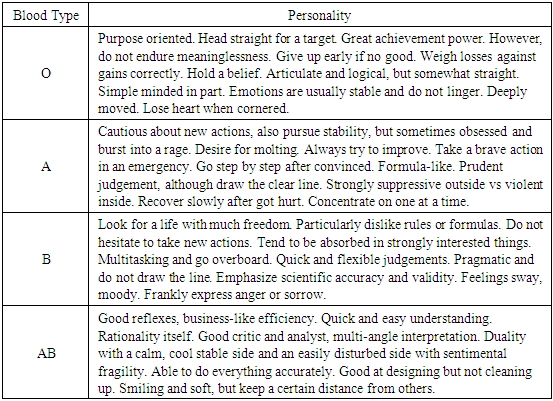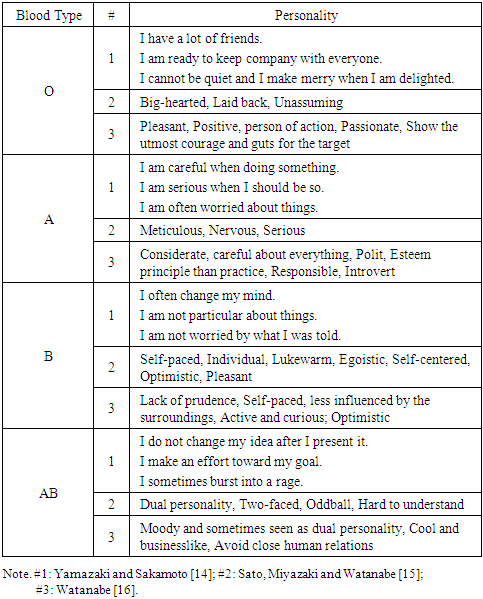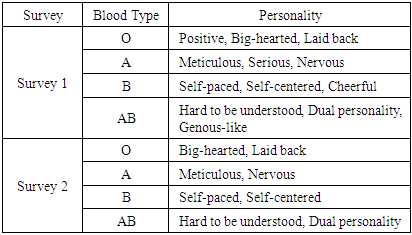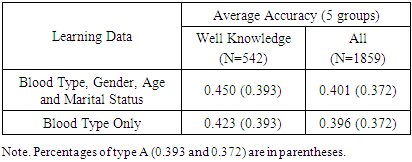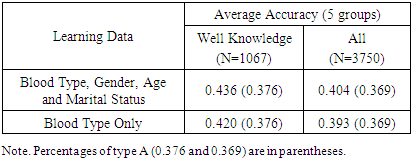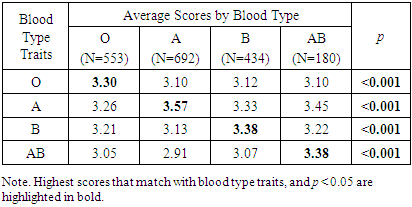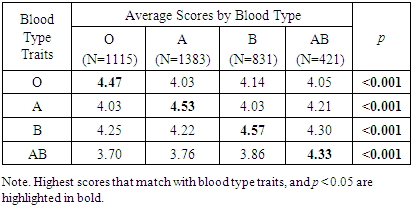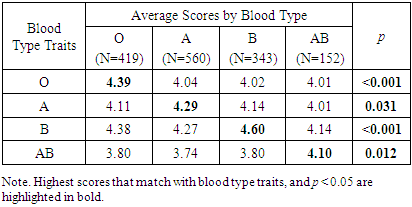-
Paper Information
- Paper Submission
-
Journal Information
- About This Journal
- Editorial Board
- Current Issue
- Archive
- Author Guidelines
- Contact Us
American Journal of Intelligent Systems
p-ISSN: 2165-8978 e-ISSN: 2165-8994
2021; 11(1): 1-7
doi:10.5923/j.ajis.20211101.01
Received: Mar. 12, 2021; Accepted: Mar. 28, 2021; Published: Apr. 2, 2021

A Pilot Study Using AI for Psychology: ABO Blood Type and Personality Traits
Masayuki Kanazawa
Human Sciences ABO Center, Tokyo, Japan
Correspondence to: Masayuki Kanazawa, Human Sciences ABO Center, Tokyo, Japan.
| Email: |  |
Copyright © 2021 The Author(s). Published by Scientific & Academic Publishing.
This work is licensed under the Creative Commons Attribution International License (CC BY).
http://creativecommons.org/licenses/by/4.0/

The relationship between blood type and personality has long been one of the more challenging issues of scientific studies. Several large-scale surveys were conducted to address the issue, and some of them had shown statistically significant associations. Presently, more than half of Japanese people feel that the relationship is legitimate. This pilot study analyzed data from two large-scale surveys (Survey 1: N = 1,859, Survey 2: N = 3,750) to examine the relationship between blood type and personality. AI predicted blood types of participants more than by chance. The ANOVA results of large-scale surveys showed that respondents displayed the personality traits corresponding to their own blood type more strongly than respondents who had different blood types did. This finding was consistent across all traits, and all differences were statistically significant. The same differences in scores were found in the groups who reported no blood type personality knowledge, although the values were smaller. We observed a clear and significant relationship between blood type and personality in large-scale surveys.
Keywords: AI, Blood type, Personality, Large-scale survey
Cite this paper: Masayuki Kanazawa, A Pilot Study Using AI for Psychology: ABO Blood Type and Personality Traits, American Journal of Intelligent Systems, Vol. 11 No. 1, 2021, pp. 1-7. doi: 10.5923/j.ajis.20211101.01.
Article Outline
1. Introduction
1.1. Blood Type Personality Theory
- Currently, the effect of genetic factors on personality is estimated to be approximately 50% [1-3]. The ABO blood group, discovered by Landsteiner in 1901, is a genetically determined and easily measured biological marker. Hence, much research has been conducted not only on health risks, but also on its impact on personality.The relationship between blood type and personality is studied at an international scale, and the first academic examination using a statistics base was conducted in 1927 by Furukawa, a Japanese educational psychologist [4-9]. Yet, the epoch that most shapes present-day research is a Japanese book written by Nomi [10], a Japanese independent researcher [4-9].Nomi adopted the multiple method approach (Table 1) which consisted of a) questionnaires on the tratis of people's behavior and mindset; b) surveys of blood type distribution for various occupations and specialties; c) observations of people's behavior and statistical analyses. The sample sizes of these studies were claimed to be tens of thousands of people. He also suggested that there was a d) association with disease and physical constitution [11].
|
1.2. Results of Previous Studies
- Japanese psychologists reported the following images of each blood type. Yamazaki and Sakamoto conducted a survey of 177 college students on 24 personality traits in the annual opinion poll by JNN Data Bank, a department of Tokyo Broadcasting Corporation, one of the major television networks in Japan [14]. Sato, Miyazaki and Watanabe surveyed 197 college students and the results of free answers [15]. Watanabe extracted personality traits of each blood type from three or more books and asked 102 college students whether they were applicable [16]. These results are shown in Table 2. Generally, the personality traits studied by Japanese psychologists were consistent with those of Nomi (Table 1).
|
1.3. Self-fulfilling Prophecy
- Self-fulfilling prophecy refers to the phenomenon in which a person who believes in a prophecy learns to act in accordance with the prophecy, thereby bringing the prophecy to being. An example that psychologists have studied is astrology [17-19]. If a person's original personality and his/her sign matches, that tendency becomes stronger. Even if the personality and the sign do not initially match, the personality moves toward what has been indicated. In Japan, South Korea, and Taiwan, roughly half of the people feel the relationship between blood type and personality is legitimate [7,9,20-22]. Logically, the self-fulfilling findings among astrology suggest that one's personality would change in a direction that fits relevant as personality description – of which shown by blood type.Utilizing those items (Table 2), several large-scale surveys in Japan were designed or re-analyzed by psychologists or other academic researchers after 1990, which clearly confirmed self-reported personality traits using ANOVA. Archetypical sample sizes of these were 6,660 [23], 11,766 [24], 32,347 [14,25] and over 200,000 (our estimation; the exact number was not specified in this report, although it alluded the size was much larger than preceding ones) [26]. Until now, statistical differences had not been confirmed in respondents without blood type personality knowledge. Therefore, the current scientific consensus is that these differences are self-fulfilling phenomena induced by the “contamination by knowledge.” However, there was little testing of whether the questions used in these studies were suitable for examining differences among less knowledgeable respondents.
1.4. Contemporary Trends and Issues
- After 2000, a growing number of studies proved the previously questioned link between blood type and physical constitution: this demonstration proposed a new approach to medicine [27-28]. For example, more than 10 studies had reported a relationship between susceptibility to COVID-19 and blood type [29-31]. According to these studies, type O was the least susceptible, and type A the most.There had also been several studies on biological factors, which investigated whether physical constitution affected personality. A US researcher examined the linkage of disequilibrium between the ABO and DBH genes [32-33]. In 2015, using DNA testing technologies, a genotype of ABO blood type and the personality using the Temperament and Character Inventory (TCI) [34-35] had been determined to be related, as predicted by blood type personality theory [36]. In this study, type A was found to be the most “persistent.”Since blood type is information that is uniquely determined for each individual, predicting blood type is a typical example of “supervised learning” for AI. This is a technique in which the machine learns the personality data (training data) with the blood type as the correct answer. In this study on human personality, therefore, we use both traditional statistical analysis methods and machine learning, which can theoretically handle data of non-linear models. With the progress of information technology, conducting crowdsourced surveys has become much easier. Nowadays, a larger amount of data can be obtained at a lower cost and in a shorter period. Since machine learning requires a large sample size, this study utilizes a crowdsourced large-scale survey of thousands of people. This makes it possible to analyze not only conventional statistical analysis methods, but also the influence of non-linear models such as self-fulfilling prophecies, gender, and age.Most Japanese people know their blood type since, until recently, it had been common practice to test the blood type of newborns. This means that analyzing the effect of the phenotype (O, A, B, AB) eliminates physiological type testing, and therefore our survey can be completed via the Internet. Presently, computer performance has improved significantly, and the use of readymade AI, such as the AWS ML (Amazon Web Service Machine Learning), eliminates technical and time-consuming issues, e.g. the construction of training models from scratch.We make reference to a facial recognition article written by AI engineers aimed at prediction [37], because there is virtually no preceding research available to analyze personality with AI; it is for this reason we utilized AI as an experimental method.
2. Participants and Methods
2.1. Participants
- Each participant’s blood type of was determined by self-report, because most Japanese people know their blood type as previously stated.With the intention of avoiding ethical issues, question items on blood type traits of this study were extracted from reviewed academic articles (Table 2). These items were checked again at the previously stated crowdsourcing company which has been passed the Japanese privacy mark (JIS Q 15001). The company confirmed that there was no problem with the question items. It provides customers with anonymized data and obtains informed consent from participants (respondents) prior to its surveys.Survey 1 was conducted in 2019, and covered 2,000 Japanese people ages 20-59, were asked to rate a total of 12 items representing 4 blood type traits (Table 3), each with scores of 1-5 for their personality traits (the larger the number, the more fitting the trait), asked the respondents to answer which blood type they thought these 12 items would categorize, and scores of 1 to 4 of relationship and their knowledge on the level between blood type and personality (the larger the number, the more related or informed), and marital status. Survey 2 was conducted in 2020, and covered 4,000, twice as many as the previous one, also Japanese people ages 20-59, with blood type traits reduced to 8 items (Table 3). In Survey 2, we changed scores of personality traits from the 5-point scale to the 7-point.
|
2.2. Analytical Strategy
- Firstly, we examine whether AI predict participants’ blood type more than chance. Secondly, we focused our analysis on whether personality self-fulfillment was occurring or not: with data from participants who “have no knowledge of blood type traits” or “do not believe in the relationship” (hereinafter abbreviated as “no-knowledge group”). Our analytical methods on personality were as follows:Analysis 1: Blood type prediction using AIAnalysis 2: ANOVA of blood type and personality of the whole participantsAnalysis 3: ANOVA of blood type and personality of the “no-knowledge” groupAll the data of Survey 1 were stored in Amazon S3, and with Amazon Machine Learning, all 12 traits, including gender, age, and marital status, were used as training data for prediction targeting for the blood type, since Nomi claimed that these elements affected personalities. Multinominal logistic regression algorithm was chosen for the prediction. We divided the whole data into five groups of same sample size. Each group was estimated as the prediction data, the rest four groups as the training data, and then the average of the five predictions was calculated. In these cases, since the sample sizes of the AI training data were small (this means that the prediction errors might become larger if we used the raw data of 1-year increment of age), a dummy variable of 10-year increments was used [20s = 2, 30s = 3, 40s = 4, 50s = 5]. The same methods were used as Survey 2.An analysis of variance (ANOVA) was performed with personality traits scores as the dependent variables and self-reported ABO phenotypes (O, A, B, AB). We set the alpha level to 0.05. Before ANOVA analyses, the normality of distributions was checked for each personality trait score; this showed a normal distribution. The data were analyzed using jamovi software version 1.2.27 [39].
3. Results
3.1. Analysis 1: Blood Type Prediction Using AI
- In Survey 1, the accuracy rates were 0.450 (F1 = 0.450) in the group that had good knowledge of blood type traits (542 participants with scores equal to 3 or higher in both item “relation” and item “knowledge”), and 0.401 (F1 = 0.401) in the entire 1,859 participants (Table 4). When gender, age, and marital status were excluded from both the learning and training data, the accuracy rates fell to 0.423 (F1 = 0.423), and 0.396 (F1 = 0.396) respectively. The most common blood type among Japanese is type A, which accounts for 0.372 (692 persons) in this survey. Hence, the accuracy rate became 0.372 if all the participants were assumed to be the type. Amazon Machine Learning predicted the blood type at a higher accuracy than this value in all cases.
|
|
3.2. Analysis 2: ANOVA of Blood Type and Personality of the Whole Participants
- In Survey 1, all traits showed the same results as those shown for blood type traits in the preceding psychology studies (Table 2). All traits were statistically significant at p < 0.05 (Table 6). All the responses were consistent with the most common images of blood types that respondents expected. All of the responses were consistent with the most common images of blood types that respondents expected, except “cheerful”, which was to be type B in academic studies, but type A got the highest score.
|
|
3.3. Analysis 3: ANOVA of Blood Type and Personality of the “No-knowledge” Group
- In Survey 1’s 621 “no-knowledge” participants, all traits showed the same results as those shown for blood type traits in the preceding psychology studies (Table 2). Two traits of all four were statistically significant at p < 0.05 (Table 8).
|
|
4. Discussion
- Preceding research by psychologists had concluded that there appeared no difference in personality among blood types, and that even if there was a difference predicted by the blood type, it was assumed to be the result of self-fulfillment prophecy phenomena [14,17-19,20,23,25-26]. However, the same differences in scores were found in the “no-knowledge” groups, although the values were smaller. Therefore, it is highly likely that differences by blood type are real, not caused by self-fulfilling prophecy phenomena; no difference in the “no-knowledge” groups were caused by Type II errors.In addition, backed on this study’s AI result, it was suggested that these phenomena occurred not only because of the wording of question items, but also because gender and age were not taken into account. Our experimental blood type predictions by AI (Amazon Machine Learning) in this study found that adding non-blood type variables, such as gender or age, to the training data considerably increased the accuracy (Tables 4 and 5). Moreover, when performing blood type prediction, AI sometimes failed to build its machine learning models, if gender or age of the training and prediction data were different. In this respect, AI technology may suggest that factors such as gender and age affect the traits of blood type. Therefore, gender, age, and other factors may offer a better explanation, even if past data were inconsistent.The issue concerning the difference of human personality affected by gender and age, have been explored in the fields of personality psychology and social psychology. Although some people argue that personalities are affected by gender and age, and the differences are non-linear [40-41], others argue that they are not affected [42]. In any case, many researchers seem to agree upon the existence of differences, at least self-reported. We also believe that there are such differences.Our study has several points to be improved. Firstly, the participants in this study were limited to Japanese populations only. It is necessary to examine whether the same results can be obtained in samples of other countries. Secondly, we used the 2,000- and 4,000-population AI training data, but these are relatively small sample sizes; 10,000 or more persons are desirable. Lastly, researchers have not yet found an appropriate method to utilize AI for personality psychology.
5. Conclusions
- AI predicted the blood type of participants more accurately than chance. We found a clear relationship between blood type and the self-reported personality of many question items, which matches traits previously stated. The same traits were observed in the no-knowledge groups, though the difference was smaller. Our findings provide a new, if hypothetical, framework of how genes affect human personality.Meanwhile, the sample in this study was limited to Japanese populations only, the AI training data was small in sample size, and its use experimental. Additional research using a larger, global dataset is needed in order to address true implications, as well as to improve algorithms and methodologies.
ACKNOWLEDGEMENTS
- The author is grateful to Chieko Ichikawa, Director of the Human Sciences ABO Center, for her support. The author also thanks Professor Qinglai Meng of Oregon State University, as well as Fred Wong, co-founder of AI Hong Kong Limited, for their kind comments and suggestions.
 Abstract
Abstract Reference
Reference Full-Text PDF
Full-Text PDF Full-text HTML
Full-text HTML